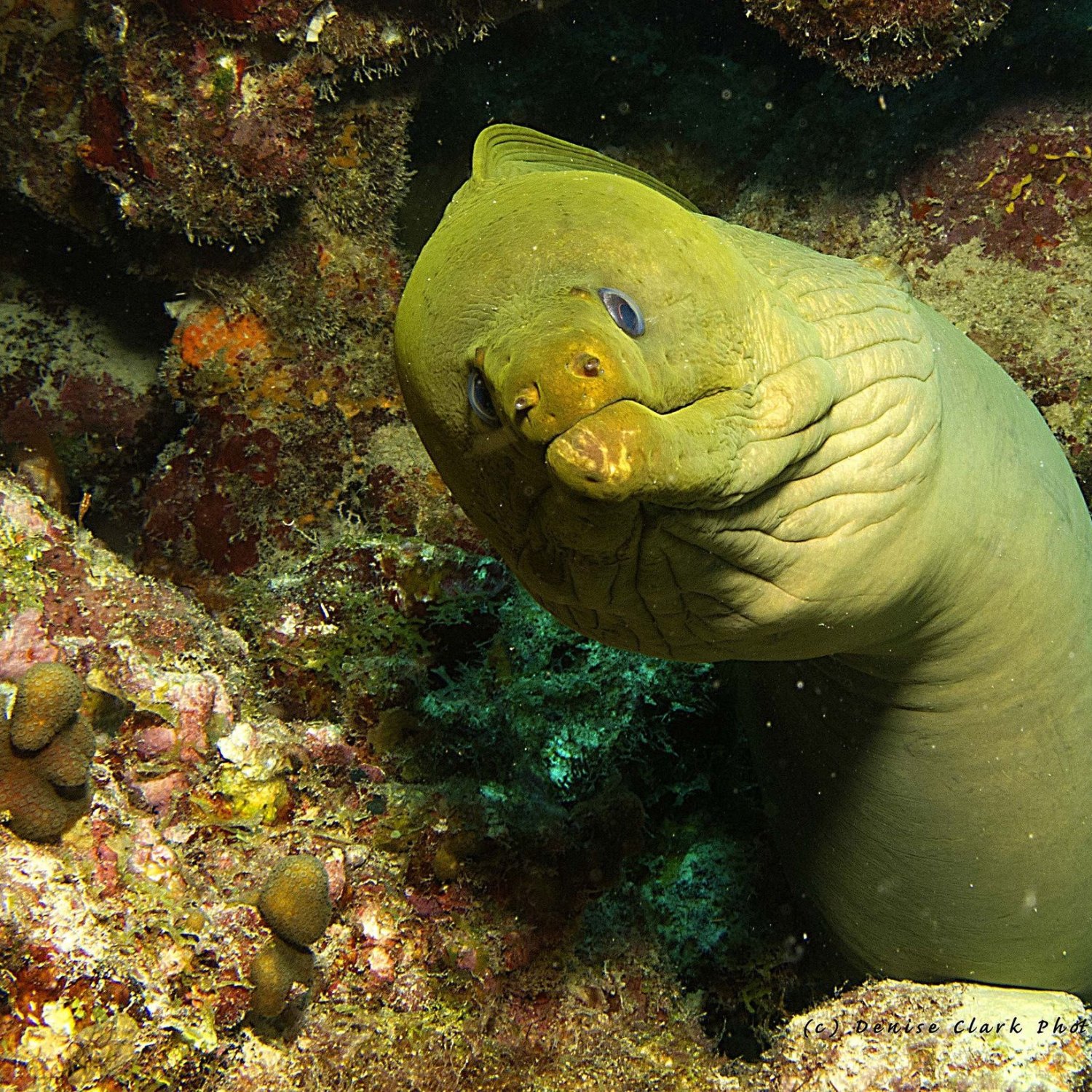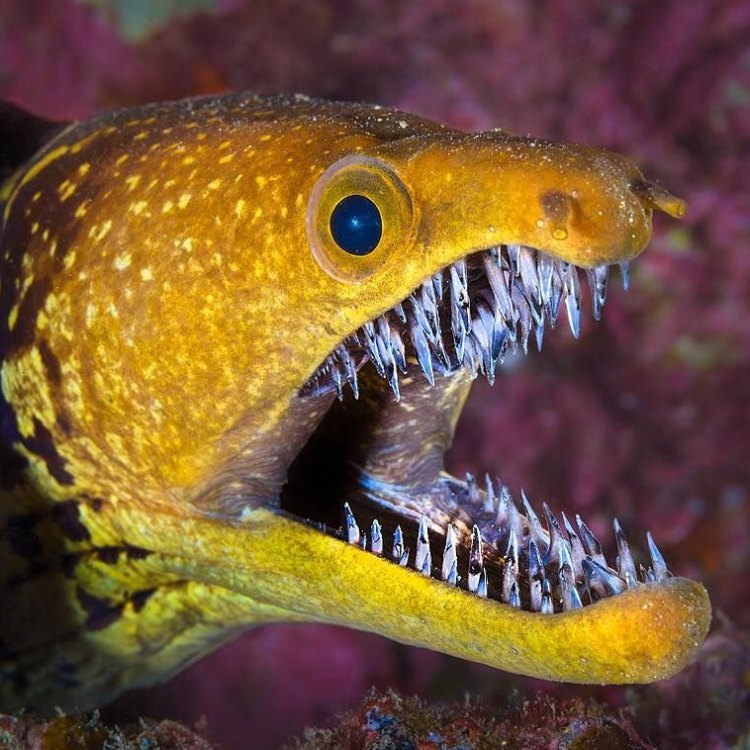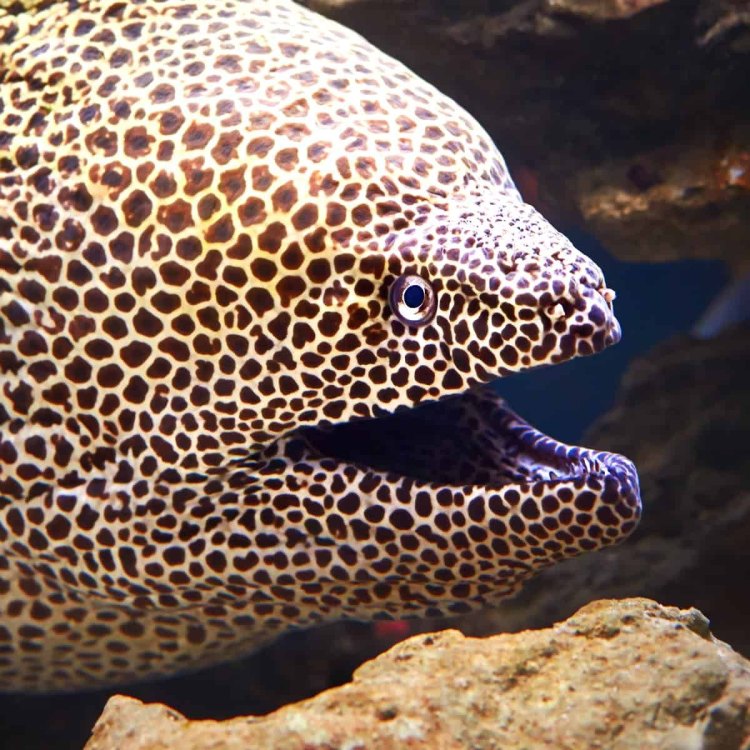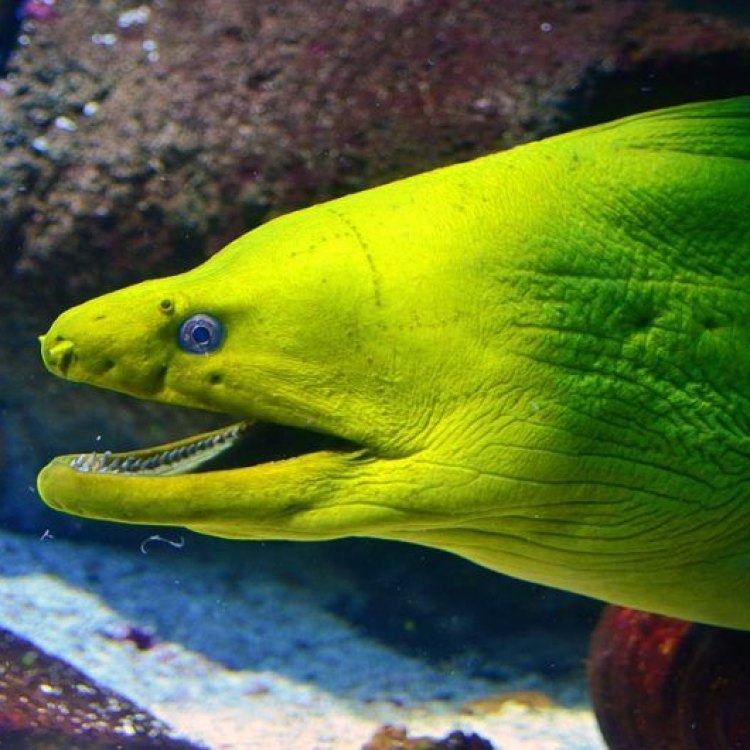
Eel
Varies depending on species, can range from 5 inches to 13 feet
Eels are fascinating creatures found in rivers, lakes, estuaries, and oceans. With their slender and elongated body shape, these creatures belong to the family Anguillidae. Depending on the species, their length can range from 5 inches to a whopping 13 feet! These unique creatures have captured the attention of scientists and have become a popular delicacy in many cultures. From their mesmerizing movements to their adaptation to various aquatic habitats, eels truly are a wonder of nature.
Animal Details Summary:
Common Name: Eel
Kingdom: Animalia
Habitat: Freshwater, marine
The Fascinating World of Eels
When we think of ocean creatures, we often picture colorful fish, majestic whales, and playful dolphins. However, there is one creature that may not immediately come to mind, but is just as intriguing and mysterious – the eel. These fascinating creatures have captured the imagination of humans for centuries with their unique features and behavior. In this article, we will explore the world of eels and learn more about their scientific classification, habitats, feeding methods, geographical distribution, appearance, and behavior Eel.What is an Eel?
Eels are a type of ray-finned fish and are part of the family Anguillidae. They belong to the order Anguilliformes, which includes other elongated fish like moray eels and conger eels. The scientific name for eels is Anguilla, derived from the Latin word for "eel". They are also commonly known as eels.Classifying Eels
Eels belong to the kingdom Animalia, which includes all animals. Within this kingdom, they are classified into the phylum Chordata, class Actinopterygii, and order Anguilliformes. The class Actinopterygii is a large group of fish that have fins supported by bony rays. This group includes familiar fish like tuna, trout, and perch. The order Anguilliformes consists of over 800 species of eels, with new species still being discovered Embolotherium.Habitat of Eels
Eels are found in both freshwater and marine environments, making them a highly adaptable species. They are found in various bodies of water such as rivers, lakes, estuaries, and oceans. Freshwater eels often begin their lives in freshwater before migrating to the ocean and then returning to freshwater to reproduce. Marine eels, on the other hand, spend their entire lives in the ocean.Feeding Behavior
Eels are carnivorous, meaning they feed on other animals. They have a varied diet, depending on their size, age and habitat. Smaller eels feed on crustaceans, worms and small fish, while larger eels can prey on larger fish, including squid and octopus. They have powerful jaws and sharp teeth that help them catch their prey.Global Distribution of Eels
Eels have a widespread distribution, being found in bodies of water all over the world. They are most commonly found in the temperate and tropical regions of the Atlantic, Pacific, and Indian Oceans, as well as in the Mediterranean Sea. They are also found in some regions of North and Central America, Europe, Africa, and Asia.The Colorful World of Eels
Eels come in a variety of colors, depending on the species. They can range from shades of brown to green, yellow, or silver. Some eels have intricate patterns on their bodies, making them intricately beautiful creatures. These colors not only help them blend into their surroundings, but also serve as a warning to predators or attract potential mates.Unique Body Shape
One of the most striking features of eels is their elongated, slender body shape. They have a snake-like appearance, with their smooth, scaleless skin making them look almost alien. Their bodies are designed for stealth and agility, making them expert hunters. They have a fin on their back called a dorsal fin, which helps them move forward, and a continuous fin on their underside called an anal fin, which helps them move backward. These fins also help with stability and navigation in the water.Size Variations
Eels are a diverse group of fish, with over 800 species. As such, their size can vary greatly, depending on the species. The smallest eel, the swamp eel, can grow up to only 5 inches, while the largest species, the giant moray eel, can reach up to 13 feet in length. This size difference is also reflected in their weight, with the giant moray eel being able to reach over 60 pounds.Nocturnal and Solitary Creatures
Eels are predominantly nocturnal, meaning they are most active at night. During the day, they often hide in crevices or burrow in the substrate to avoid being seen by predators. They are also solitary animals, preferring to live alone rather than in groups. This behavior makes them elusive and difficult to study, adding to their mystery.A Fierce Traveler
Eels are known for their impressive migratory abilities, being able to travel thousands of miles to reach their destination. Freshwater eels, for example, start their journey in rivers and lakes, swimming to the ocean where they spend most of their adult lives. When it is time to breed, they return to the exact same location where they were born. This impressive navigational ability is still a mystery to scientists and has captured the attention of researchers for years.In Conclusion
Eels may seem like an ordinary fish at first glance, but upon closer inspection, we can discover their unique characteristics and behavior. From their adaptable habitat and feeding methods to their diverse colors and impressive migratory abilities, eels are truly fascinating creatures. As research on eels continues, we can only hope to unravel more of their mysteries and gain a deeper understanding of these enigmatic creatures. So the next time you see an eel, take a moment to appreciate their beauty and complexity – for they are truly one of the most intriguing animals in the world.

Eel
Animal Details Eel - Scientific Name: Anguilla
- Category: Animals E
- Scientific Name: Anguilla
- Common Name: Eel
- Kingdom: Animalia
- Phylum: Chordata
- Class: Actinopterygii
- Order: Anguilliformes
- Family: Anguillidae
- Habitat: Freshwater, marine
- Feeding Method: Carnivorous
- Geographical Distribution: Worldwide
- Country of Origin: Various countries
- Location: Rivers, lakes, estuaries, and oceans
- Animal Coloration: Varies depending on species, can be brown, green, yellow, or silver
- Body Shape: Slender, elongated
- Length: Varies depending on species, can range from 5 inches to 13 feet

Eel
- Adult Size: Varies depending on species, can range from 8 inches to 8 feet
- Average Lifespan: Varies depending on species, can range from 4 to 50 years
- Reproduction: Sexual
- Reproductive Behavior: Eels migrate to the Sargasso Sea to reproduce
- Sound or Call: No specific sound or call
- Migration Pattern: Eels undertake long-distance migrations for reproductive purposes
- Social Groups: Solitary, but may aggregate in spawning areas
- Behavior: Nocturnal, secretive
- Threats: Habitat loss, pollution, overfishing
- Conservation Status: Varies depending on species, some are critically endangered
- Impact on Ecosystem: Eels play important ecological roles as predators and prey
- Human Use: Commercial fishing, aquaculture
- Distinctive Features: Long, snake-like body with no pelvic or pectoral fins
- Interesting Facts: Eels have a complex life cycle, including a larval stage known as leptocephalus
- Predator: Larger fish, birds, marine mammals

Anguilla
The Fascinating World of Eels: From Mysterious Migrations to Critical Conservation
When you think of eels, what comes to mind? Perhaps a slimy, snake-like fish that is commonly found in sushi dishes? While this may be true, there is so much more to these fascinating creatures than meets the eye. Eels have a complex and intriguing life, with unique features and behaviors that make them stand out in the world of fish. From their long migrations to their important role in ecosystems, let's dive into the world of eels and uncover what makes them so special.Eels can be found in freshwater, brackish, and marine habitats all over the world PeaceOfAnimals.Com. There are over 800 species of eels, with varying sizes and lifespans. The smallest eel species can reach up to 8 inches, while the largest can grow up to a staggering 8 feet in length. Their lifespan also varies depending on species, with some living for only 4 years and others living up to 50 years.
Despite their diverse sizes and lifespans, all eels share a common reproductive behavior – they are sexual animals. This means that they require both male and female individuals to reproduce. However, their method of reproduction is quite unique. Eels are catadromous, meaning they migrate from freshwater to the ocean in order to reproduce. The exact reason for this behavior is still a mystery, but it is believed that the journey to the ocean allows the eels to mature and better prepare for reproduction.
Eels undertake long-distance migrations, sometimes traveling thousands of miles, to reach their reproduction grounds in the Sargasso Sea, a region in the North Atlantic Ocean European Wildcat. This epic journey is a feat of strength, endurance, and determination. Eels are able to navigate through different habitats and adapt to changing salinity levels on their journey, showing off their incredible resilience.
While they are on their migration, eels are solitary creatures. However, during the spawning season, they gather in large groups in certain areas of the Sargasso Sea. Once spawning is complete, the eels then make their long journey back to their original freshwater habitats. It's a miraculous journey that happens every year, and yet, it remains largely a mystery to us.
One of the most unique and interesting features of eels is that they do not produce any specific sound or call. In fact, they are mostly quiet creatures, stealthily swimming through water with almost no sound at all. This makes them excellent predators, able to sneak up on their prey without alerting them.
Eels are nocturnal animals, meaning they are most active during the night. This, coupled with their elusive and secretive behavior, makes them difficult to spot in the wild. They prefer to hide in crevices and under rocks during the day, only coming out at night to hunt for food. This makes them a challenging species to study, and there is still much to learn about their behavior and habits.
Unfortunately, eels are facing numerous threats that are affecting their populations. Habitat loss due to human development, pollution from agricultural and industrial practices, and overfishing are just some of the major issues that eels are facing. In fact, several species of eels are now classified as critically endangered, highlighting the urgency of conservation efforts.
The decline of eel populations not only has an impact on their own species but also on the entire ecosystem they inhabit. Eels play important ecological roles as both predators and prey. They are voracious predators, feeding on a variety of organisms such as fish, crustaceans, and even other eels. This helps to keep their prey populations in check, ensuring the balance of the ecosystem. Eels also serve as an important food source for larger fish, birds, and marine mammals, making them a vital link in the food chain.
Aside from their ecological significance, eels also hold value for humans. They are commercially fished for their meat, which is considered a delicacy in some cultures. Eel aquaculture, or farming, is also a growing industry, providing a sustainable source of food for human consumption.
Eels' distinctive features make them easily recognizable. They have long, slimy bodies with no pelvic or pectoral fins. This gives them a unique, snake-like appearance, making them stand out among other fish species. Their bodies are also covered in a layer of mucus, which helps them to navigate through tight spaces and protects them from predators.
But perhaps the most fascinating aspect of eels is their complex life cycle. Eels go through several stages of development, including a larval stage known as leptocephalus. During this stage, eels are transparent and almost flat, with tiny, undeveloped eyes. They spend most of their time drifting in ocean currents, where they feed and grow. After a few months, they transform into miniature versions of adult eels and head towards freshwater habitats.
In the wild, eels face many predators, both in their freshwater and marine habitats. Larger fish, birds, and marine mammals all pose a threat to eels. But eels have developed some interesting defense mechanisms to protect themselves. Some species of eels have a sharp spine at the base of their gill covers, which they can use to inflict harm on predators. Others have the ability to produce large amounts of mucus to create a slippery, slimy barrier against predators.
In conclusion, eels may not be the most popular or well-known creatures in the ocean, but they certainly have a lot to offer. With their unique features, secretive behavior, and complex life cycle, they continue to intrigue and fascinate scientists and marine enthusiasts alike. However, the threats they face and their declining populations are a cause for concern. It is important for us to understand and appreciate the important role that eels play in our oceans and to work towards their conservation. Only then can we ensure that these mysterious creatures continue to thrive in their natural habitats for generations to come.

The Fascinating World of Eels
Disclaimer: The content provided is for informational purposes only. We cannot guarantee the accuracy of the information on this page 100%. All information provided here may change without prior notice.












